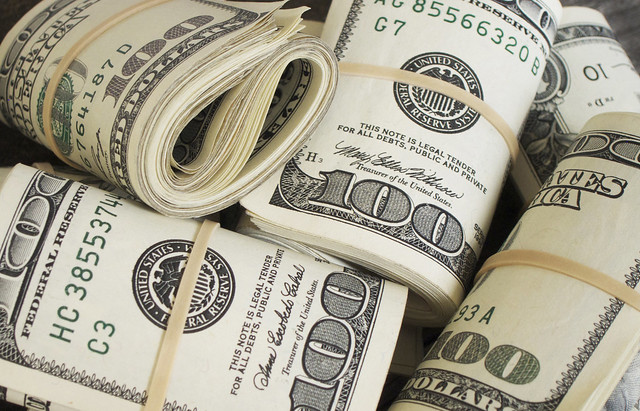Recently, President Biden introduced a $1 Trillion infrastructure plan targeted to improve highways, bridges, and public transportation and to support clean water, as well as clean energy.
He also proposed a $3.5 Trillion 10-year initiative to improve health care, education, family services and environmental programs.
Together, these add up to $450 Billion dollars a year- over and above the “normal” costs of running the Federal government.
At the same time, Biden has pledged not to raise taxes on Americans earning less than $400,000 a year.
So, who’s going to foot the bill?
We all know that our country is divided politically. But the division between the very rich “1%” and everyone else is so vast that if someone were to propose a novel based on the premise of this divide, the manuscript might be rejected as unbelievable.
Here are the facts.
- The population of the U.S. is about 332 Million. There are approximately 128 Million households.
- The infamous 1% is therefore comprised of 1.3 Million households. (1% x 128 Million).
- The average net worth of these households is about $11 Million. They control 32% of the net worth of all American families.
- By way of contrast, the bottom 50% of our population accounts for a mere 2% of total net worth. The Tax Policy Center recently reported that 61% of all American taxpayers paid no tax at all in 2020.
Here are a couple of refinements to the above numbers.
- The top ½ of 1% of American households (1/2 x 1% x 1.3 Million= 650,000 households) have an average net worth of $17 million.
- The top 1/10 of 1% of American households (1/10 x 1% x 1.3 Million = 130,000) have an average net worth of $43 Million. This includes between 600 and 700 Billionaires.
If we assume, for now, that the top ½ of 1% should be expected to collectively come up with $450 Billion a year for 10 years to cover Biden’s proposed spending measures, each of the “lucky” households would have to contribute almost $700,000 a year-over and above what most of us would expect them to pay just to cover “normal” federal budgetary expenses.
Is this reasonable?
I suggest that no substantial benefit would result from raising the top marginal tax rate a few percentage points for households with incomes over $400,000 a year, as President Biden has suggested. As I will explain shortly, many of the “super rich” are able to reduce their taxable incomes to zero, and, whether the tax rate is 40% or 90%, multiplying by zero is… ZERO.
A major tax-system overhaul is needed, and to be effective, I believe it will require some radical out-of-the-box thinking.
President Biden and his advisors will not, in my opinion, be able to rely on input from our top tax lawyers and accountants in the private sector. This is because most, if not all, of these specialists rely on the very wealthy for their incomes.
Moreover, plugging loopholes and introducing new tax rules designed to extract money will not be popular with the wealthy benefactors who contribute to the coffers of our political parties.
Personally, I have no dog in the hunt. I am knocking on the door of my 78th birthday. My career has been devoted to taxation for (literally) the last 50 years in both the U.S. and Canada. I hold CPA designations in both countries. I taught at several major Canadian universities and, for the past 22 years, have been providing courses for Canadian CPAs who are studying to obtain accreditation in the U.S.
So, what I would like to do is present several ideas in this three-part series in the hope that someone who reads these articles and thinks my suggestions have merit has the connections to pass them to the appropriate channels.
Here is my first proposal.
I have already stated that a number of very wealthy Americans pay no tax by reducing their taxable incomes to zero each year. The way they accomplish this, is by not drawing salaries from their businesses and not selling shares or other properties that would trigger capital gains.
Instead, they use their substantial assets as collateral and borrow money to cover their living expenses year after year.
Here is a hypothetical example.
- M. Smart is a tech guru who founded a start-up business some years ago that grew and prospered and is now listed on the NASDAQ. Mr. Smart’s holdings are now worth in excess of $2 Billion. He does not want to draw a big salary. There are two reasons for this. First, salaries reduce the company’s “earnings per share” and have a negative impact on the share price. Secondly, Mr. Smart hates to split his good fortune with the IRS. His problem, however, is that he “needs” $2 Million a year to cover his lifestyle expenses.
Fortunately he becomes aware of a solution that was discovered many years ago by other mega-wealthy people, Mr. Smart approaches his bankers and asks for a personal loan of $2 Million and pledges some of his shares worth, say, $10 Million as collateral. From the bank’s standpoint, there is virtually no risk in providing the money. Mr. Smart can now spend to his heart’s content. Moreover, he can borrow money in the same way year-after-year. It would probably take several lifetimes before he exhausts his ability to draw against his holdings!
Eventually, Mr. Smart will either sell his company or die. Capital gains and/or estate taxes will become payable and the loans will have to be paid off. Nevertheless, if he can postpone paying taxes for, perhaps, 30 years or more, that’s not a bad deal, is it?
Sadly, President Biden will not be able to count on Mr. Smart to help fund his spending proposals- unless the Internal Revenue Code is amended.
So, what can be done?
The answer is to make all loans in excess of some base amount (to be determined) taxable when they are received, unless the money is clearly used to make investments or is used to acquire or renovate a principal residence or purchase an automobile .
I suggest that dollar limit exemptions should be set for residences and cars. The base exemption should also cover loans for education and medical expenses. This base exemption would be large enough so that only around the top 5% of American households might be affected.
If (taxable) income is later used to repay loans previously taken and taxed, the borrower would get a corresponding deduction at that time- unless the repayment is offset by replacement borrowings.
Let’s assume for example, that 25% of the top ½ of 1% of American households are using loans to avoid taxes on $5 Million each year. As I mentioned towards the top of this article, there are about 650,000 households with an average net worth of $17 Million. So, if 162,500 households are required to cough up, say, $2 Million tax on $5 Million each year, this would bring in about $325 Billion a year!
(Please note: If these people stop taking loans and draw salaries from their enterprises to cover their living expenses, the IRS coffers would still collect the same $ 325 Billion.)
My conclusion is that blocking the “annual loan” loophole by itself would generate a substantial portion of the funds needed over the next 10 years to pay for President Biden’s spending proposals.
In my next installment in this series, I will explain how estate and gift taxes can be totally abolished while overall taxes payable by America’s wealthiest citizens will nevertheless increase!





















I’m looking forward to future installments you indicate are coming. I have questions regarding a proposal or two I’ve seen in the last couple of years but I’ll hold off for now as you’ve already brought up something interesting. Are the next articles in the works and if so might when we expect to see them?
Parts 2 and 3 will run next week.
Not to be nit picky (ok, totally in the honorable tradition of nitpickiness)…but 61% paid no federal taxes, not no taxes. Someone making minimum wage in California contributes about 10.5% of their jet income to state and local taxes.
And 2020 was an unusual year, full of tax breaks and stimulus.
Those are essential caveats, because when the right wing portrays us as a nation of poor freeloaders and wealthy individuals sacrificing greatly, we need the context that illustrates that everyone has skin in the game, and I think a lot of people would agree that the working poor paying a tenth of their income is a pretty decent contribution.
“The Tax Policy Center recently reported that 61% of all American taxpayers paid no tax at all in 2020.”
WRONG.
WRONG.
WRONG.
Unless these people were absolutely not working and were not shopping, these people paid taxes.
There are 5 states with no state sales tax: Alaska, Delaware, Montana, New Hampshire, and Oregon. (Information per Investopedia and Kiplinger.)
There are 7 states with no personal state income tax: Alaska, Florida, Nevada, South Dakota, Texas, Washington, and Wyoming. (Per Investopedia and TurboTax; AARP adds New Hampshire and Tennessee.)
But folks living in EVERY STATE IN THE UNION pay federal income tax *IF* they’re employed. (And many states also include unemployment compensation as “taxable income!”)
Now, after various deductions and allowances built into the tax code, much of that “61%” got REFUNDS on the tax money they paid through withholding but that is a FAR different notion than “paid no tax at all.” I’d also ask what the “paid no tax in 2020” means in terms of paying. Are we talking about based on their earnings in 2019 (which is when most people think of “paying my taxes in 2020”) or based on their earnings in 2020 (which would definitely be skewed as people were put out of work due to a certain little pandemic)?
But putting out this “paid no tax” nonsense is exactly what’s led to all these damn GOP-led tax cuts. They keep pressing this false statement to make their base think that *THEY* are working and being taxed to cover all the “leeches” and “welfare bums” and “illegals.”
I do NOT want to see this nonsense put up on this website WITHOUT it being stated PROPERLY.
I also criticized this, then when you wrote about people receiving tax refunds, it made me wonder what a “non-payer” means in this study, exactly.
First, you are sort of incorrect in what you wrote when you discuss refunds. A “non-payer” isn’t someone who owed nothing or got a refund. If I paid $4,000 in withholdings over the year, then got a $1,000 refund, the study still would consider me someone who paid federal taxes.
HOWEVER HOWEVER HOWEVER, and this is vital (thus the bad grammar) – the stimulus payments are considered federal income tax deductions in this study. So if an individual got the 4/20 $1200 payment and the $600 12/20 payment, $1800 is taken off their tax payments. This is a reason the non-payer numbers are so high. Low income individuals almost all had their tax burdens offset by the stimulus.
I don’t entirely agree with using this methodology. The stimulus wasn’t sold as a tax break, and was offered to most everyone. And even if we consider it an offset to taxes, why offset it against only 2020 taxes? Unemployment is paid into over time for benefits when needed. It would also make sense to consider the stimulus a tax break over several years. I understand why the study takes this approach…it’s the only way to easily calculate the weird year. But it has created a false impression of who is contributing. Someone who used their stimulus to wipe out taxes still made a sacrifice…there was an opportunity cost there.
Sorry. The Tax Policy Center reported that 61% of American taxpayers paid no FEDERAL tax in 2020. I agree that 2020 was a
Unique situation because of stimulus payments and the forgiveness of tax on the first $10,200 of unemployment benefits.
Rory
The whole point of the article is to figure out how to close loopholes used by the super- rich to avoid income taxes.
The average family may or may not contribute a whole lot to the taxman. However, the average family is not going to make a dent in the financing requirements of new $4.5 Trillion expenditure plan.
This article has a fulty premise.
1. The US Government, and its licensed agents, are the monopoly issuer of the US dollar.
2. The US Dollar is the only thing accepted in payment of Federal Taxes. So everybody needs to get some.
3. The US Government, as the sole issuer, declares what you need to do to get some dollars, whether it is join the military, build a bridge, work as a teacher, etc. This sets the value of the Dollar.
4. The Dollar is also used in domestic commerce because of #2. That is how you get the money in your wallet or bank account, even if you do not directly provide a service to the government.
5. Issuing the dollars as in #3 costs the government nothing. No labor, no material, nothing. (Paper money and coins are the least part of the public money supply.) It is created out of thin air by act of Congress. It says so in the Constitution and subsequent laws.
So the government does not tax anybody to raise ‘income’. It taxes people so that they will need some Dollars, so they will provide services that the Government needs.
This is Modern Monetary Theory, and it is over 20 years old. It is supported by much research.
Hi Paul
You said “So the government does not tax anybody to raise ‘income’”
Yes, The government can print as much money as it wants. However, they also produce an annual budget and, eventually , an annual statement of actual receipts and expenditures. If you add $4.5 Trillion over time to the expenditures without a corresponding “income”, the deficit increases accordingly.
If there is a deficit that our trading partners deem unacceptable, the dollar will fall. Imports will become more expensive.
Therefore, the government will need a great deal of taxation revenue (“income”) to support these new potential expenditures. Unfortunately, there are relatively few people and corporations who might realistically shoulder this burden.
The purpose on my three articles is to suggest ways that the very rich can be forced (they won’t like it one bit) to meet these “income” requirements. The “old way” of raising taxes at the top bracket by a couple of percentage points won’t accomplish anything significant.
Despite what Ronald Reagan said, the federal government ‘budget’ is not like a household one. The government never borrows money, for one thing – it doesn’t need to. The “Debt” to GDP ratio in the US is about 120%. Japan’s is twice that. Nobody seems to mind.
It is using terms like “income” is misleading. Taxing the rich is an excellent idea for several reasons, but raising ‘income’ to ‘pay for’ projects is not one of them.